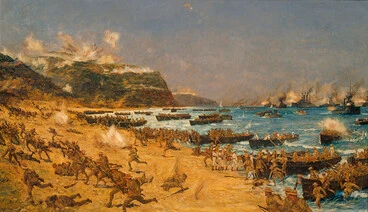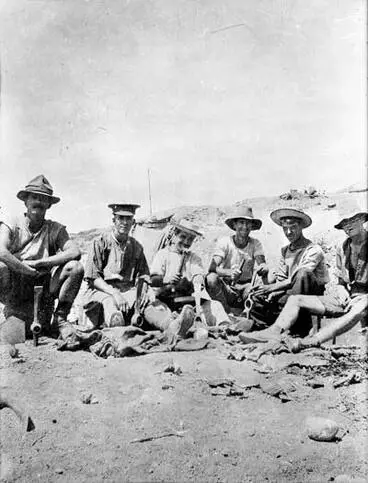Anzac Day
A DigitalNZ Story by Elizabeth
What does this place, person, object, or practice tell us about how New Zealanders have expressed their identities in the past? Does this confirm or complicate traditional depictions of 'Kiwi culture.'
The practice of Anzac Day commemoration in New Zealand, which occurs every year on the 25thof April [Rolfe, 1997, pg 19], is an example of how New Zealanders express their past identities. Anzac Day commemoration shows this expressed identity through the Anzac Myth, kept alive through productions such as “Once on Chunuk Bair.”; the nationwide commemoration and memorialisation; and the passed down meanings of Anzac Day. When discussing national identity, this essay will define it as “a shared understanding of the characteristics and behaviors that distinguish one nation from other nations” [https://teara.govt.nz/en/new-zealand-identity/page-1]. Through the New Zealand identity expressed since the Gallipoli landing, we see howthrough national commemoration of Anzac Day, we have a confirmation of typical depictions of 'kiwi culture'.
The Landing at Anzac, 25 April 1915
Archives New Zealand Te Rua Mahara o te Kāwanatanga
Landing at Gallipoli
Archives New Zealand Te Rua Mahara o te Kāwanatanga
Anzac Day Commemoration is when the country of New Zealand comes together on the 25th of April to remember [Rolfe, 1997, pg 19] the Australian and New Zealand Army Corps that landed on Gallipoli in 1915 [Rolfe, 1997, pg 10]. The ANZAC troops were unsuccessful in capturing the Dardanelles, resulting in 2721 young New Zealanders dying, and as a consequence, Anzac Day has become a national day of remembrance [Rolfe, 1997, pg 10]. This tradition began on the 25th April 1916 at Serapeum in Egypt, and was organised by retired soldiers from the battle field [Rolfe, 1997, pg 10]. By 1916, the 25th of April was already being called 'Anzac Day' [Rolfe, 1997, pg 38], and by 1920 the 'Anzac Day Act' was passed which made it an official holiday from 1921 onwards. [Werry, 2013, pg 43].
Anzac Day as a national holiday.
All shops shut in respect of the holiday.
Archives New Zealand Te Rua Mahara o te Kāwanatanga
Similarly to other legends, the Anzac legends meanings and forms have been contested since its birth, and there are many different interpretations [Thompson, 1991, pg 21&22]. Maurice Shadbolt is credited for reviving the myth through his play “Once on Chunuk Bair” [Wilson, 2016, pg 27]. Shadbolt’s play is about the Wellington Infantry Battalion’s assault and their moment of glory while holding the ridge at Gallipoli on 8 August 1915 [Wilson, 2016, pg 27]. This play draws on the myth that Gallipoli marked the birth of New Zealand as a nation freed from British imperialism, how New Zealand “came of age that day on Chunuk Bair” [Wilson, 2016, pg 27 &28]. The play also depicted New Zealand’s loss of innocence, with Shadbolt’s aim being to revive the Anzac legend from the 1950s and 70s where it faced some unpopularity, and to mythologize the catastrophe [Wilson, 2016, pg 28]. Shadbolt was unwavering in his commitment to appropriate a foundational myth for New Zealand, one that would remain in cultural memory [Wilson, 2016, pg 32].
“Once on Chunuk Bair” resonates more with the time in which it was produced than that of which it represents [Wilson, 2016, pg 41]. During the 1970s the Vietnam war protests caused hostility to war in New Zealand, combined with ties being severed politically and economically with Britain in 1973, causing the Anzac legend to fade [Wilson, 2016, pg 41]. However, Shadbolt did strike a chord with the New Zealand public during a time of rising nationalism in the 1980s [Wilson, 2016, pg 42], but now there is questions of how “Once on Chunuk Bair” will survive as new interpretations and understandings of the Anzac myth emerge [Wilson, 2016, pg 43]. The importance of the myth, which was reasserted in the 1980s, has since acquired more importance in the new millennium as new evaluations of Anzac emerge as New Zealand’s national day [Wilson, 2016, pg 43]. If anything, the use of playwriting from Shadbolt has increased public understanding of the Gallipoli campaign, and confirmed the myth as a cornerstone of the nation’s identity, to be retold to every generation in the hope of binding people with their past [Wilson, 2016, pg 47]. It is this effort to keep the myth alive that allows Anzac Day commemoration to continue to be expressed by New Zealanders in their past identities.
Anzac propoganda poster.
The New Zealand governments use of Anzac to create a shared sense of national identity.
Museum of New Zealand Te Papa Tongarewa
"Once on Chunuk Bair."
a photo from Maurice Shadbolts production.
Manatū Taonga, the Ministry for Culture and Heritage
Anzac Day, through commemoration and memorialization, tells us how the New Zealand identity has been expressed in the past 103 years. New Zealanders have a patriotic spirit in regard to honouring their past, which can be reflected by the numbers of young New Zealanders at commemorations [https://teara.govt.nz/en/political-values/page-4]. Anzac Day is when New Zealanders commemorate their dead in all wars now [Pugsley, 2004, pg 313], not just the Gallipoli landing in the first world war. It is a day when the people gather as citizens to remember, honour, asses why we fight, and to measure their success as a nation [Pugsley, 2004, 313]. The importance of commemoration is visible in regard to every town having a memorial, recording all the names of the service men who died in war [Rolfe, 1997, pg 7]. Every Anzac Day, thousands of New Zealanders will gather around these memorials and lay wreaths to remember those men and women who died [Rolfe, 1997, pg 7]. It is very important to New Zealanders that these people are remembered [Rolfe, 1997, pg 7], they died believing they were fighting to protect the freedom and way of life that New Zealanders have [Rolfe, 1997, pg 9]. It is precisely this commitment and ideology behind commemoration and memorialization that allows Anzac Day to tell us that New Zealanders take a great pride in their historical identity, refusing to forget what happened or the meaning behind it.
Anzac Day ceremony, Wellington
Alexander Turnbull Library
Remembering.
All types of people remember during Anzac Day, children included.
Auckland Libraries
Anzac Day has a lot of meaning to New Zealanders which allows us to interpret its historical significance to the country and its national identity, as the experience is interwoven into how New Zealanders see themselves as a nation [Pugsley, 2004, pg 11]. The urge to remember Anzac Day has been a powerful stimulus to the public, often seen as an imperative [Macdonald, 2015, pg 17]. The fact memorials are scattered across the country allows memory to be at the centre of public life in New Zealand [Macdonald, 2015, pg 20]. The word Anzac came to be understood for bravery, gallantry and loyalty which New Zealanders are proud to say are qualities upheld by all New Zealand soldiers, airmen, and sailors who have served [Rolfe, 1997, pg 11].
To give an understanding of New Zealand’s close knit nature, there are accounts of Anzac soldiers who describe how they knew twenty school mates killed at Gallipoli [Rolfe, 1997, pg 13]. It is precisely this small community mindset that impels New Zealanders to remember those who serve their country, and fills them with pride when they remember them.
Commemoration.
Anzac Day commemoration occurred all over the world, not just in New Zealand.
Antarctica New Zealand
To conclude, Anzac Day is a day of commemoration in New Zealand that binds New Zealanders together through a shared historical identity and respect. This is shown through the production “Once on Chunuk Bair” which keeps the history of what happened alive. Similarly, this is shown through the dedication over the past century to commemoration, memorialization, and the shared importance of the need to remember which has been passed down throughout the generations. Through the previous examples, we can see that Anzac Day confirms traditional depictions of ‘Kiwi culture’ as prioritizing the values of mateship, loyalty, and a nationalistic pride in the ‘birth of New Zealand on the world stage.’
Remembering.
Here we see an old man laying a wreath as a symbol of respect
Auckland Libraries
Bibliography:
Alister Thompson, A past you can live with: Digger memories and the Anzac legend in Anzac: Meaning, memory and myth, (London: The University of London, 1991).
Charlotte Macdonald, The First World War and the Making of Colonial Memory in Journal of New Zealand Literature (JNZL) no. 33, part 2.
Christopher Pugsley, The Anzac Experience: New Zealand, Australia and Empire in the First World War, (Auckland: Reed Books, 2004).
Fiona Barker, 'New Zealand identity - Understanding New Zealand national identity', Te Ara - the Encyclopedia of New Zealand, http://www.TeAra.govt.nz/en/new-zealand-identity/page-1 (accessed 5 April 2019).
Janet Wilson, ‘Colonize. Pioneer. Bash and slash’: Once on Chunuk Bair and the Anzac Myth, in Journal of New Zealand Literature (JNZL) no 34, vol 1.
Jim Rolfe, Should we forget? The significance of Anzac Day, (Lower Hutt: Valley Printing Company, 1997).
Philippa Werry, Anzac Day: The New Zealand Story, what it is and why it matters, (Auckland: New Holland publishers Ltd, 2013).
Stephen Levine, 'Political values - The fair society', Te Ara - the Encyclopedia of New Zealand, http://www.TeAra.govt.nz/en/political-values/page-4 (accessed 5 April 2019).








